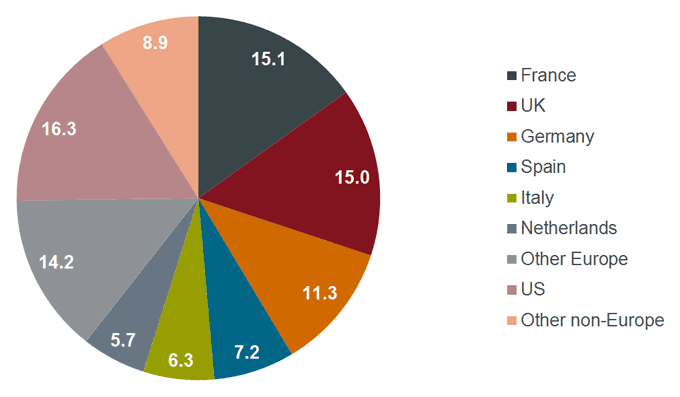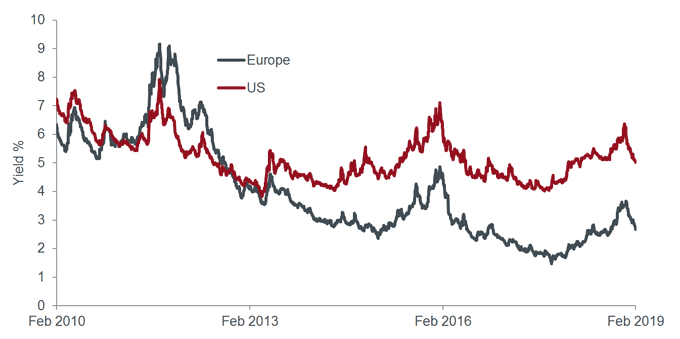Subscribe
Sign up for timely perspectives delivered to your inbox.
Tom Ross and Tim Winstone, Corporate Credit Portfolio Managers, explore the reasons why US companies are borrowing through European bond markets and why this creates potential opportunities for investors.
From the arrival of American soldiers in the Second World War, and indeed well before, through to the present day, America has had a strong relationship with Europe, bonded by cultural and linguistic ties. More recently, however, the political gaze of the White House has shifted away from the Atlantic and towards the Pacific, where a resurgent China is becoming a direct competitor to the US’ economic hegemony.
While the political focus may be shifting, corporate America is still attracted to Europe. In no small part, this is due to cheaper financing costs. At a time when the US Federal Reserve’s policy rate is at 2.25-2.5%, the European Central Bank’s key policy rate remains stuck at zero. This ultimately feeds through to borrowing costs in the broader economy, with sovereign and corporate bonds typically trading at lower yields in Europe.
When a US company issues a bond in a market outside the US, in a currency other than the US dollar, this is known as a ‘Reverse Yankee’. This follows from the fact that, when a non-US company issues bonds denominated in US dollars in the US it is known as a ‘Yankee Bond’, so when US companies perform this act in the other direction it acquires the ‘reverse’ prefix.
There are a number of reasons why a company may wish to issue bonds in an overseas market:
The yield cannot just be looked at in isolation. The company will also consider the appetite of the market for an issue and the likelihood of getting the order book for the bond filled. Currency hedging costs will also be a consideration, particularly for those US companies with bigger domestic revenues and fewer European revenues, for which it is more likely euro funding will be swapped back into US dollars.
At the end of February 2019, US companies accounted for 16.3% of the ICE BofAML European Currency Non-Financial High Yield 2% Constrained Index. In fact, a further 8.9% of this high yield index is from non-European issuers.
 Source: Bloomberg, ICE BofAML European Currency Non-Financial High Yield 2% Constrained Index, as at 28 February 2019.[/caption]
Source: Bloomberg, ICE BofAML European Currency Non-Financial High Yield 2% Constrained Index, as at 28 February 2019.[/caption]
The US weighting represents a rise from just 2.5% five years ago and is back to about the same level as 10 years ago, when it stood at 16.6%. The drop off in Reverse Yankee weighting in 2014 reflects the fact that the Eurozone debt crisis was its height between 2010 and 2012 and borrowing in the preceding years in Europe became more costly than in the US (see Figure 2), providing little incentive for US issuers to cross the Atlantic.
 Source: Bloomberg, 28 February 2010 to 28 February 2019, ICE BofAML Euro High Yield BB Index (HE10), ICE BofAML US High Yield BB Index (H0A1), yield to worst.[/caption]
Source: Bloomberg, 28 February 2010 to 28 February 2019, ICE BofAML Euro High Yield BB Index (HE10), ICE BofAML US High Yield BB Index (H0A1), yield to worst.[/caption]
How does the weighting of Reverse Yankees in European high yield compare to that within the European investment grade market? The US weighting is remarkably similar. Some 16.2% of the investment grade ICE BofAML Euro Corporate Index is represented by US companies. There has been a surge in Reverse Yankee borrowing: issuance in the first ten weeks of 2019 among non-financial investment grade issuers has already exceeded the total for the whole of 2018, although last year was affected by tax reform in the US encouraging US companies to bring their cash home.
Are there investment advantages to overseas issuers raising funds in Europe? First, these US companies bring further diversification to the European high yield market and are a welcome addition when supply from domestic high yield European issuers has been slim. US issuers are well represented across sectors, covering 13 of the 15 sectors (as at 28 February 2019) and include household names, such as Avis, the car rental company, Levi Strauss, the clothing company, Netflix, the media group, and Iron Mountain, the data storage company. They therefore allow European investors to gain exposure to US credit risk, without having to take the currency risk of buying US dollar-denominated bonds.
Second, they can provide mispricing opportunities for investors. If a US borrower is less well known in Europe, it may have to offer higher credit spreads than a similar European company to attract investors. The US issuer may be just as, if not more, creditworthy than its better-known European counterpart, creating an opportunity for European investors with strong knowledge of US issuers to potentially profit from this market inefficiency.
Glossary
Currency hedging: the act of entering into a financial contract to protect against changes in currency exchange rates.
Investment grade: investment grade corporate bonds are issued by companies that are rated by credit rating agencies as being high quality.
High yield: A high yield bond is a bond with a lower credit rating than investment grade corporate bonds. The higher risk of not meeting their repayment obligations to investors means these bonds typically pay a higher yield than investment grade bonds.